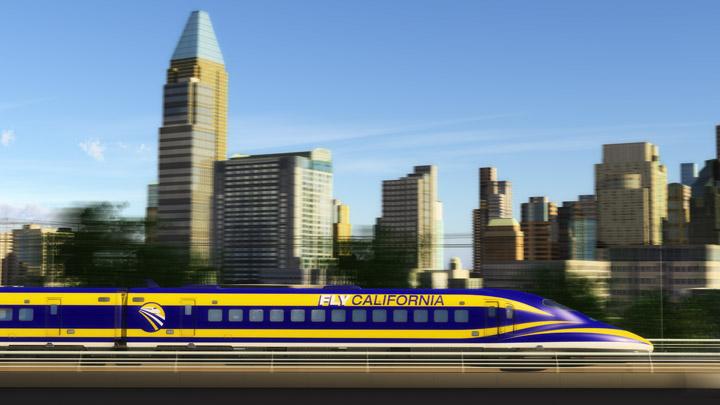 Courtesy of California High-Speed Rail Authority
Courtesy of California High-Speed Rail AuthorityLast year, California residents voted in favor of Proposition 1A, which provides funding for a high-speed rail train from San Diego to San Francisco and Sacramento. Today, government officials such as Gov. Arnold Schwarzenegger are collaborating with California citizens to provide the state with the most efficient and sustainable method of transportation.
With a total of 36.8 million residents last year, California’s population has increased 8 percent within the past nine years, according to the California Census Bureau. It is also estimated that San Diego alone will add one million people to its population by 2040.
This growth helps the state by bringing in more revenue through taxes and new businesses, but a problem arises because its infrastructure was simply not built for this amount of people. Sitting in traffic has become part of the everyday routine for many Californians. Three of the top five most congested areas in the nation are in California, according to the California High-Speed Rail Authority.
While California grows at a rapid speed, a worldwide movement toward sustainability or “going green” has emerged. Experts speculate that Earth’s natural oil supply will reach its usage capacity within the next few years, if it has not already been exhausted as some scientists believe.
The environmental impact of carbon dioxide emissions is no longer a hot topic solely for scientists. Average citizens have become concerned about the diminishing health of the environment. Education regarding the protection of Earth’s resources has infiltrated mediums across the spectrum, from mainstream television, to college professors to political activists such as Al Gore.
Just as people are aware of the need to sustain the planet, California faces an unemployment rate of 12 percent. This rate is even greater than the national unemployment rate. State school budget cuts are only one of several indicators that the Golden State is not in “golden” condition.
Perhaps the issues of overpopulation, environmental concerns and economic troubles convinced the majority of citizens to vote in favor of a high-speed train in California. The rail may be an optimal solution to help improve the state’s troubling condition.
California’s High-Speed Rail will run from San Diego to Sacramento / San Francisco, moving at more than 200 miles per hour. Voters approved a rail, which will provide a convenient, safe and affordable alternative to driving. The route includes major state cities, such as Anaheim, Ontario, Irvine, Bakersfield, San Francisco, San Jose and many more.
The nearly 600-mile trip from San Diego to Sacramento will cost riders approximately $70, take approximately four hours, and save nearly 500 pounds of CO2 gas emissions. This is a dream come true for the large number of San Diego State students who call Northern California home and need to travel there for the holidays.
Last Thursday evening, the Design Innovation Institute held a forum at Point Loma Nazarene University to educate San Diegans about the high-speed rail. Board members informed the audience of the crucial need for energy, rejuvenation and sustainability. Different speakers detailed how the rail will benefit California and how this type of innovation is the future of transportation.
“Finding a solution to gas will not solve the problem. Cars will remain the same size and so traffic jams are not minimized,” board member and urbanist Rich Flierl said. He, along with the rest of the Design Innovation Institute, believes intelligently designed public transportation, such as high-speed rails, is the answer to saving the future because it will minimize the environmental impact as well as the problems of traffic congestion.
“If we want things to change, we must look at our inputs. We must sort these inputs by toxicity and then design choices to eliminate these toxicities,” board member and professor of strategy and sustainability Harry Watkins said.
“How would nature design a city? Interconnected.”
Watkins compared city designs of the Spanish colonists who set the first formations of California to the visions of the Design Innovation Institute. What both the old and new plans have in common were communities that were well-linked. The California high-speed rail will provide the state with a network that allows people, goods and services to be more efficiently connected.
The forum was held in Point Loma, a neighborhood that would be greatly affected by the high-speed rail as it is close to the San Diego International Airport. The airport is limited on room as the city’s population has boomed. The high-speed rail would directly minimize air traffic in and out of the airport and potentially decrease airfare rates because of decreased demand.
While the rail will cost` approximately $45 billion, it would cost the state more than double this amount to fix the congestion problems will worsen with continuing population growth. It is also estimated that the rail will raise more than $1 billion annually throughout the state.
Traffic jams currently cost the state $20 billion a year because of wasted fuel and lost time according to the California High-Speed Rail Authority. The CHSRA also projects that 160,000 construction jobs and 450,000 permanent jobs will be added to the economy.
High-speed rails have already been implemented around the world. Germany, known for its advanced engineering, Italy and Japan, are proud operators of fast, environmentally-friendly and efficient public transportation systems. In Italy, transportation by train is a part of everyday life, and benefits not only the country but the environment as a whole.









